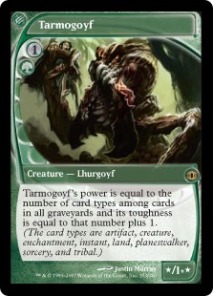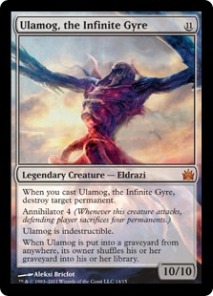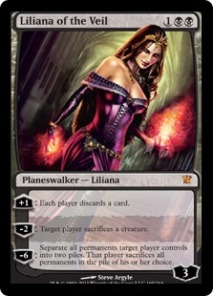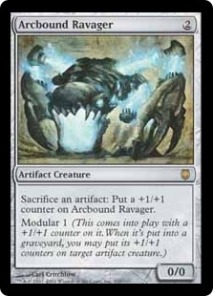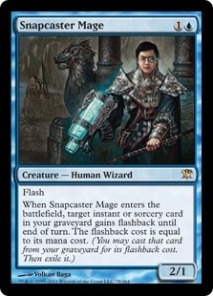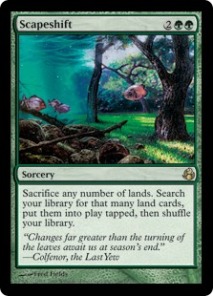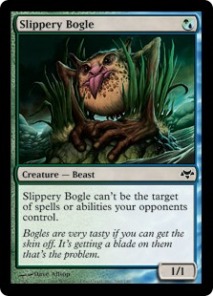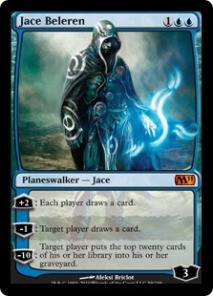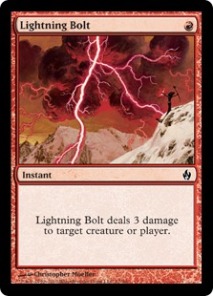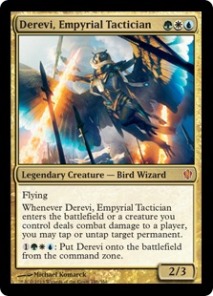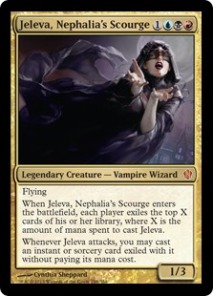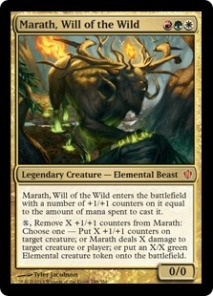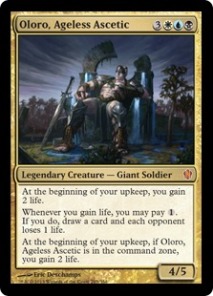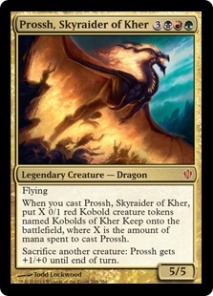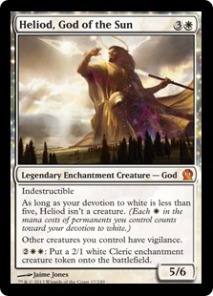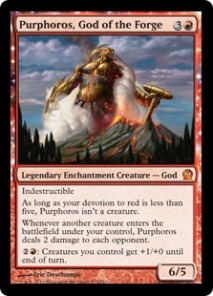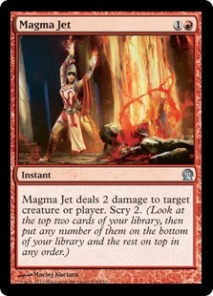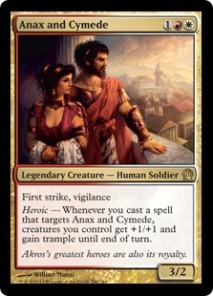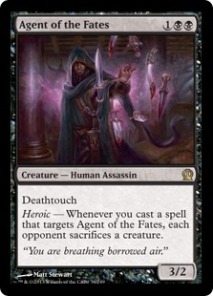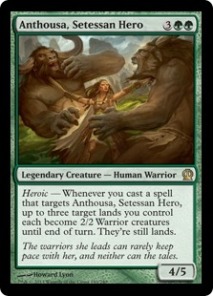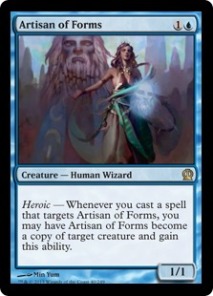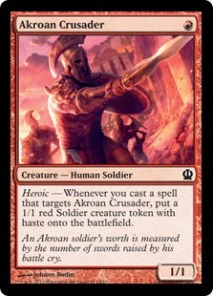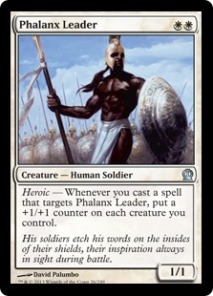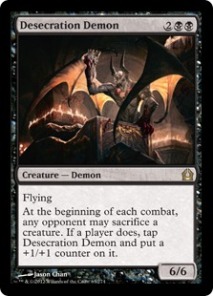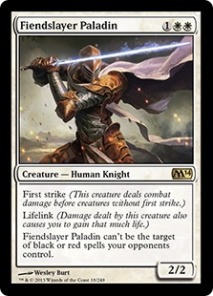Ok so after my, frankly, unprofessional moan about modern, I’ve decided to take some good advice and spend some time talking about the second-tier decks. These are decks that are not the main staples and, as such, do not have a large price tag, making them more accessible, but are, at the same time, nearly as competent and consistent as the higher-level decks.
The deck I am going to focus on today is a deck I ran in a Modern tournament held by the York Travelling Man last Sunday. It is a variation on a deck called “Slippery Bogles.” Below is the deck list, along with the average price of the individual cards on StarCityGames in dollars. After showing you the decklist I used, I will talk a bit about how the deck works (although it will be obvious once you see the list) and also tell you about the cards I would like to put in to it.
Right so let’s get on with this.
Creatures
4 x Slippery Bogle ($0.49 each = $1.96)
3 X Invisible Stalker ($0.99 each = $2.97)
4 x Gladecover Scout ($0.25 each = $1.00)
1 x Sun Titan, Duel Deck Promo ($2.99)
1 x Silhana Ledgewalker ($0.49)
Other Spells
4 x Ethereal Armour ($0.25 = $1.00)
4 x Spider Umbra ($0.49 = $1.96)
4 x Hyena Umbra ($0.25 = $1.00)
4 x Spectral Flight ($0.25 = $1.00)
3 x Rancor ($1.99 = $7.96)
3 x Keen Sense ($3.99 = $15.96)
4 x Path to Exile ($5.99 = $23.96)
Lands
4 x Sunpetal Grove ($2.99 = $11.96)
3 x Razorverge Thicket ($2.99 = $8.97)
3 x Glacial Fortress ($2.99 = $8.97)
2 x Temple Gardens ($9.99 = $18.98)
2 x Breeding Pools ($7.99 = $15.98)
2 x Hinterland Harbour ($3.99 = $7.98)
1 x Forest, ($0.10)
1 x Island ($0.10)
3 x Plains ($0.10 = $0.30)
So that’s a total value of $135.59, if you bought each card separately from StarCityGames. that’s about £83. For a Modern deck, that is cheap and, believe me, it works very well. So, let’s go through it bit-by-bit for those of you that don’t know how Bogles works.
Creatures – All the creatures in this deck have Hexproof, except the Sun Titan. Infact, the Bogles, Stalkers, Ledgewalker and Scout all have hexproof whilst the Stalkers are unblockable and the Ledgewalker also can’t be blocked, except by creatures with Reach or Flying. They are all 1/1’s but this is practically irrelevant as before long the other spells come into effect. The Sun Titan is a nasty little surprise as his ability to bring back anything from the graveyard with Converted Mana Cost three or less to the battlefield when he enters the battlefield or attacks allows you to start bringing back creatures and enchantments to stabilise the board or pump up for a major attack. That and, He’s a 6/6 with Vigilance.
The Other Spells – Enchantment’s Galore, Spectral Flight gives enchanted creature +2/+2 and flying, Keen Sense means that whenever the enchanted creature deals damage to a players’ life points you get to draw a card, Hyena Umbra and spider Umbra both give enchanted creatures +1/+1, with Hyena also giving it First Strike and Spider giving it Reach. The Umbas also get destroyed instead of the enchanted creature if the creature would be destroyed so they are a great failsafe for if an opponent DOES find a way to deal with your creatures. Rancor gives the enchanted creature +2/+0 and Trample AND it returns to your hand if it is ever sent from the battlefield to the graveyard. All these enchantments work together to make your creatures big, hard and very very scary and then you play Ethereal Armour, giving enchanted creature +1/+1 for each enchantment you control and First Strike. Those of you that are not brand new to magic will be able to see that a creature with one of each of these cards becomes a 13/11, with Hexproof (as all the creatures in the deck have Hexproof), First Strike, Reach, Trample and draw a card every time it deals damage. Hexproof makes it very difficult for your opponent to kill it and Reach makes it a good blocker, if necessary, Trample makes it hard to block profitably, then First Strike makes it even worse to Block or an even more Scary attacker.
This isn’t just a “best-case-scenario” idea though, in the four-round tournament (with each round being best-of-three) I played in recently, I regularly had creatures with Power/Toughness in double digits and loads of abilities, only getting killed through a clever trick or multiple blocks.
Lands – A mixture of White/Green/Blue multi-lands, the five basics and the four shocklands help the Sunpetal Groves, Glacial Fortresses and Hinterland Harbours to come down untapped, the Razorverge Thickets help with mana-fixing early in the game and the Shocklands themselves are very helpful.
The deck is very aggressive, usually being able to play really up the curve. Turn one, Bogle or Scout, Turn two, Umbra and Armour, attack, Turn three, Stalker and another enchantment, attack, Turn four, more enchantments and attack, maybe a path to keep you safe. Most games follow this pattern, and it will be clear really early on if you are going to win or not.
Bogles is harder for opponents to deal with than you would think, Again, the various abilities and stat increases granted by the enchantments makes them hard to block and Hexproof makes them immune to targeted removal.
Now my sideboard for this deck is unusual, but it is created with cards I felt would help in certain situations. Because none of these are part of the Decklist I have not put their values on.
1 x Mistcutter Hydra
1 x Polukranos
2 x Celestial Flare
2 x Condemn
4 x Transguild Promenade
2 x Planar Cleansing
1 x Nemesis of Mortals
2 x Forest
So the sideboard has a few questionable cards, let me start with the obvious ones first. The two Celestial flares are very handy when fighting against just about any deck (I had a particularly good Flare against Emrakul which managed to win me the duel on the next turn) and the two Planar Cleansing’s are only there because I couldn’t borrow some Supreme Verdicts. However, the Nemesis, Mistcutter and Polukranos are only in there because I like them and, truth-be-told, they didn’t see much action in the tournament except for one round where I won game one easily and only lost game two because I didn’t draw any enchantments so I decided to have some fun. Polukranos as an 8/8 (+3/+3 Monstrous) with the Hyena Umbra and a Spectral Flight is scary as anything.
I did quite well in the tournament. I won round one against a deck that was mostly Targeted burn and Seismic Assault, combined with Dredge and Life From the Loam. The pace of Bogles did very well and just over-ran it, winning 2-1. Second round was against a Controlling white deck called “Death and Taxes” which got used very aggressively and I just couldn’t keep up, even after sideboarding in my defensive cards. I lost that one 0-2. The next round went better against a “Tron” deck (using all three Urza’s lands and several of the larger Eldrazi) with me winning the first game in five turns, but my next two games were a little-off with me keeping a bad hand in the second game and forgetting some triggers in the third. I lost 1-2. The fourth round was against almost the exact-same “Tron” deck, and again I managed to out-run it for a quick win in the first game, lost the second to a very fast Emrakul. So I side-boarded in the two Celestial Flare’s and the two Planar Cleansing’s. Again Emrakul hit the field very early on but I managed to use Celestial Flare to kill it and, despite losing SIX permanents to Emrakul’s Annihilator, managed to win on the next turn with a lucky draw and some Rancors. I win 2-1.
So my score for the weekend was 2-2. There was another player there playing almost the exact same Bogles deck and he also went 2-2. These are decks that, supposedly, are not as good as the main Modern Decks, yet they managed to both get into the top eight of the 16-people tournament.
The tournament, combined with some brilliant advice I have recently received from some more-experienced writers has helped to give me a new perspective on Modern as a format. I always enjoyed the game as a casual past-time but now I am looking forward to the tournaments, I am reading up on different deck-lists and following some of the Modern pro’s for their new ideas and decks.
I have always encouraged people to play Modern but now I want to encourage people to go into the competitive scene. If you like the look of the Bogles deck, then go for it, it’s not expensive. If you don’t like the look of Bogles then go on to the web. Competitive Modern is not the money-bloated pig I made it out to be. It’s reachable, achievable and really good fun.
So, that’s all for today folks. So, keep playing and, Remember, Have Fun!
Please note I own none of the material mentioned in this article. Magic : The Gathering is property of Wizards of the Coast and I have no rights or legal ownership of any images or material used. They are used under Fair Use and I make no claims of ownership.
Also, check out our new, Harrogate based Tournament Organisers and soon-to-be collectibles store https://www.facebook.com/pages/Gatehouse-Collectables/1434717780085746









